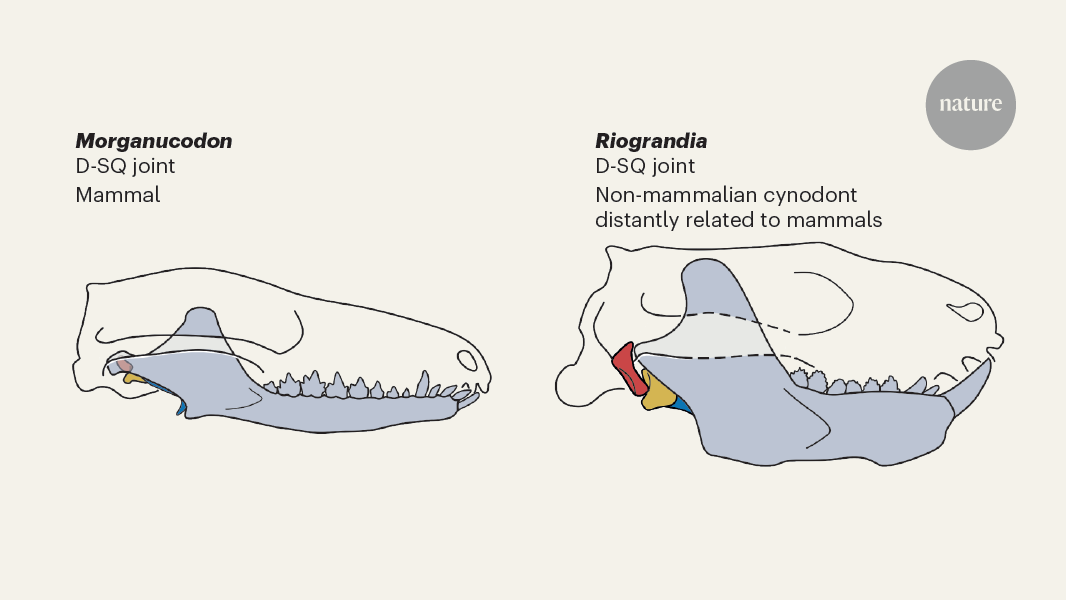ข้อมูลเชิงลึก - Evolutionary Computation - # Evolutionary Innovations in Mammalian Jaw Structures and Feeding Mechanisms
Discovery of Unexpected Jaw Structures in Early Mammalian Relatives Challenges Established Views on Mammalian Jaw Evolution
แนวคิดหลัก
The discovery of unexpected jaw structures in two ancient mammalian relatives challenges long-held assumptions about the evolution of the iconic mammalian jaw hinge.
บทคัดย่อ
The article discusses a significant discovery reported in Nature by Rawson et al. regarding the jaw structures of two ancient mammalian relatives. This finding prompts paleontologists to rethink the long-standing question of how the characteristic mammalian jaw hinge evolved.
Traditionally, the evolution of the mammalian jaw hinge has been a central theme in vertebrate evolution, as the innovation of jaw structures and feeding mechanisms is crucial for the diversification of mammals. However, the new discovery suggests that the accepted understanding of this evolutionary process may need to be revised.
The article highlights that the discovery is "surprising" and will force paleontologists to "rethink the long-standing question" about the origins of the mammalian jaw hinge. This indicates that the findings challenge the existing models and theories regarding this important evolutionary transition.
A jaw-dropping discovery about early mammals
สถิติ
Innovation of jaw structures and feeding mechanisms is an overarching theme for vertebrate evolution but especially so for mammals.
คำพูด
None
ข้อมูลเชิงลึกที่สำคัญจาก
by Zhe-Xi Luo ที่ www.nature.com 09-25-2024
https://www.nature.com/articles/d41586-024-03038-5
สอบถามเพิ่มเติม
What specific jaw structures were discovered in the ancient mammalian relatives that challenge the established views on mammalian jaw evolution?
The recent study by Rawson et al. highlights the discovery of unique jaw structures in two ancient mammalian relatives that diverge significantly from the traditional understanding of mammalian jaw evolution. Specifically, these ancient species exhibit a more complex arrangement of jaw components, including variations in the morphology of the jaw hinge and the presence of additional bones that were previously thought to be exclusive to later mammalian forms. This complexity suggests that the evolutionary pathway leading to the modern mammalian jaw was not a linear progression but rather involved a series of adaptations that incorporated diverse structural innovations. The findings challenge the established view that the mammalian jaw hinge evolved solely from a simple ancestral form, indicating that early mammals may have possessed a more sophisticated and varied set of jaw mechanisms than previously recognized.
How might this discovery lead to a re-evaluation of the current theories and models explaining the evolution of the mammalian jaw hinge?
The discovery of these intricate jaw structures necessitates a re-evaluation of existing theories and models regarding the evolution of the mammalian jaw hinge. Current models often depict a straightforward transition from reptilian jaw structures to the more advanced mammalian configurations, primarily focusing on the reduction and modification of certain bones. However, the new evidence suggests that early mammals may have utilized a broader range of jaw mechanics, which could imply that the evolutionary pressures and ecological niches influencing jaw development were more complex than previously thought. This could lead researchers to explore alternative evolutionary pathways, including the possibility of convergent evolution where similar jaw adaptations arose independently in different lineages. Consequently, the study may prompt a reassessment of the phylogenetic relationships among early mammals and their relatives, as well as a deeper investigation into the functional implications of these jaw structures in feeding and survival strategies.
What broader implications could this finding have for our understanding of the evolutionary adaptations and diversification of early mammals?
The implications of this discovery extend beyond the specific mechanics of the jaw hinge, offering insights into the broader evolutionary adaptations and diversification of early mammals. The presence of complex jaw structures suggests that early mammals were likely more ecologically versatile than previously assumed, potentially occupying a wider range of niches and exhibiting varied feeding strategies. This adaptability could have played a crucial role in the survival and diversification of mammals during critical periods of evolutionary change, such as the Mesozoic era. Furthermore, understanding the evolutionary innovations in jaw structures may shed light on the selective pressures that shaped early mammalian evolution, including competition with other vertebrates and responses to environmental changes. Ultimately, this finding enriches our comprehension of mammalian evolution, highlighting the intricate interplay between anatomical adaptations and ecological dynamics that have influenced the trajectory of mammalian diversity throughout history.
0
